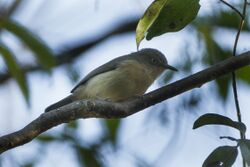Biology:Common newtonia
| Common newtonia | |
|---|---|

| |
| Scientific classification | |
| Domain: | Eukaryota |
| Kingdom: | Animalia |
| Phylum: | Chordata |
| Class: | Aves |
| Order: | Passeriformes |
| Family: | Vangidae |
| Genus: | Newtonia |
| Species: | N. brunneicauda
|
| Binomial name | |
| Newtonia brunneicauda (Newton, 1863)
| |
The common newtonia (Newtonia brunneicauda) is a species of bird in the family Vangidae. It is endemic to Madagascar .
Its natural habitats are subtropical or tropical dry forests and subtropical or tropical moist lowland forests.
It is a small bird with greyish-brown upper parts, tannish-white underparts, a black bill and golden-yellow eyes.
Taxonomy and systematics
There are two subspecies of the common newtonia:
Newtonia brunneicauda brunneicauda, Newton 1863- It is found in forested regions throughout Madagascar. Newtonia brunneicauda inornata is considered to be a synonym.
Newtonia brunneicauda monticola, Salomonsen 1934- It is found in the Ankaratra mountains of central Madagascar.[2]
Description
It is a small, short-winged, warbler like bird with relatively long legs. It is 12 cm in length and weighs 7–14.5 g, with a wing length of 54.5 mm. Sexes look similar to each other. It has grayish brown upperparts and is pale warm buff in colour under. The nominate species has a cold grayish brown head and upperparts, with the sides of head and neck being a lighter grayish-brown. Its tail is also grayish brown, with off-white undertail coverts. They also have very pale yellow irises with a slender, short, and black bill. The lining of the mouth is yellow. Its tarsi are pale pinkish to grayish brown.
Juveniles look similar to adults, but have browner upperparts, with rufous-brown tips on greater wing coverts and a ginger tinge on their tertials. Irises are darker than in adults.[3]
Ecology and behaviour
Diet
It is insectivorous.
Distribution and habitat
The species is found throughout Madagascar, from sea level up until an elevation of 2,300 m.[4] It is found through a variety of forests and wooded habitats, but is mostly restricted to native forest.
References
- ↑ BirdLife International (2016). "Newtonia brunneicauda". IUCN Red List of Threatened Species 2016: e.T22715086A94439576. doi:10.2305/IUCN.UK.2016-3.RLTS.T22715086A94439576.en. https://www.iucnredlist.org/species/22715086/94439576. Retrieved 11 November 2021.
- ↑ "Systematics - Common Newtonia - Newtonia brunneicauda - Birds of the World" (in en). https://birdsoftheworld.org/bow/species/comnew1/cur/systematics.
- ↑ "Appearance - Common Newtonia - Newtonia brunneicauda - Birds of the World" (in en). https://birdsoftheworld.org/bow/species/comnew1/cur/appearance.
- ↑ "Distribution - Common Newtonia - Newtonia brunneicauda - Birds of the World" (in en). https://birdsoftheworld.org/bow/species/comnew1/cur/distribution.
Wikidata ☰ Q1304997 entry
 |


